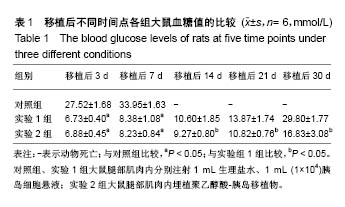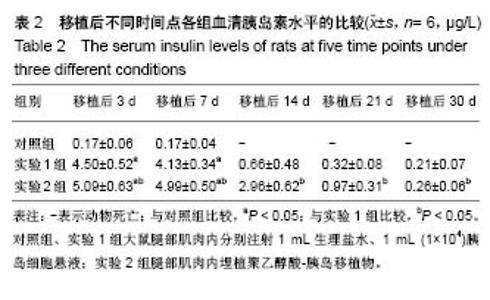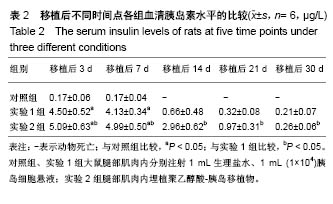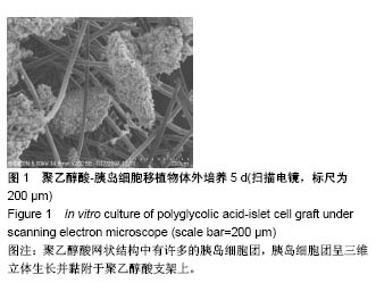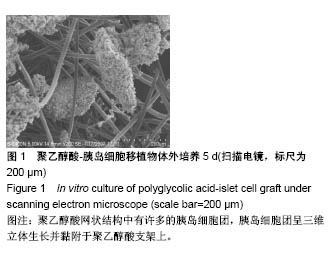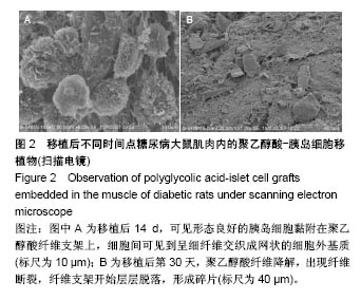Chinese Journal of Tissue Engineering Research ›› 2018, Vol. 22 ›› Issue (30): 4829-4834.doi: 10.3969/j.issn.2095-4344.0984
Previous Articles Next Articles
Polyglycolic acid-islet compound transplantation into rat leg muscles as diabetes treatment
Xie Wan-jun1, Wei Zheng2, Song Chun2
- 1Dalian Friendship Hospital, Dalian 116021, Liaoning Province, China; 2Key Laboratory of Cell Transplantation, Ministry of Health, Department of General Surgery, First Affiliated Hospital of Harbin Medical University, Harbin 150000, Heilongjiang Province, China
-
Received:2018-05-28Online:2018-10-28Published:2018-10-28 -
Contact:Song Chun, Master’s supervisor, Key Laboratory of Cell Transplantation, Ministry of Health, Department of General Surgery, First Affiliated Hospital of Harbin Medical University, Harbin 150000, Heilongjiang Province, China -
About author:Xie Wan-jun, Associate chief physician, Dalian Friendship Hospital, Dalian 116021, Liaoning Province, China -
Supported by:the National Natural Science Foundation of China, No. 30570931
CLC Number:
Cite this article
Xie Wan-jun, Wei Zheng, Song Chun. Polyglycolic acid-islet compound transplantation into rat leg muscles as diabetes treatment[J]. Chinese Journal of Tissue Engineering Research, 2018, 22(30): 4829-4834.
share this article
| [1] International Diabetes Federation.Diabetes Atlas.7t ed. Brussels:International Diabetes Federation,2015.[2] O'Sullivan ES,Johnson AS,Omer A,et al.Rat islet cell aggregates are superior to islets for transplantation in microcapsules.Diabetologia.2010;53(5):937-945.[3] Beck J,Angus R,Madsen B,et al.Islet encapsulation: strategies to enhance islet cell functions.Tissue Eng. 2007; 13(3):589-599.[4] Emamaullee JA,Shapiro AMJ.Factors Influencing the Loss of β-Cell Mass in Islet Transplantation.Cell Transplant. 2007; 16(1):1-8. [5] 宋今丹,杨恬,李丰.医学细胞生物学[M].北京:人民卫生出版社, 2004.[6] Chun S,Huang Y,Xie WJ,et al.Adhesive growth of pancreatic islet cells on a polyglycolic acid fibrous scaffold.Transplant Proc.2008;40(5):1658-1663.[7] Hou Y,Song C,Xie WJ,et al.Excellent effect of three-dimensional culture condition on pancreatic islets. Diabetes Res Clin Pract.2009;86(1):11-15.[8] 宋纯,黄玉东,侯艳,等.聚乙醇酸生物支架与胰岛的共培养[J].中国组织工程研究与临床康复,2009,13(16):3119-3123.[9] 宋纯,黄玉东,姜再兴,等.PGA细胞支架在大鼠胰岛体外实验中的应用[J].化学与黏合,2009,31(2):28-32.[10] Kandaswamy R,Stock PG,Skeans MA,et al.OPTN/SRTR 2011 Annual Data Report: pancreas.Am J Transplant. 2013; 13 Suppl 1:47-72. [11] 裴广辉,王树森.胰岛移植受者术前评价与管理[J].实用器官移植电子杂志,2016,4(3):177-179.[12] Perez VL,Caicedo A,Berman DM,et al.The anterior chamber of the eye as a clinical transplantation site for the treatment 0f diabetes:a study in a baboon model of diabetes.Diabetologia. 2011;54(5):1121-1126.[13] Rajab A.Islet transplantation:alternative sites.Curr Diab Rep. 2010;10(5):332-337.[14] Salazar-Bafiuelos A,Benitez—Bribiesca L,Sigalet DL,et al. Bone marrow as a site for pancreatic islet transplantation. Blood.2010;115(17):3643-3644.[15] 谢艳,王树森,刘蕾.异种胰岛移植的现状[J].实用器官移植电子杂志,2016,4(6):350-354.[16] 程颖.胰岛分离的研究进展[J].实用器官移植电子杂志, 2016, 4(6):345-349.[17] Rheinheimer J,Bauer AC,Silveiro SP,et al.Human pancreatic islet transplantation:an update and description of the establishment of a pancreatic islet isolation laboratory.Arch Endocrinol Metab.2015;59(2):161-170.[18] Vantyghem MC,Defrance F,Quintin D,et al.Treating diabetes with islet transplantation:lessons from the past decade in Lille. Diabetes Metab.2014;40(2):108-119.[19] Barton FB,Rickels MR,Alejandro R,et al.Improvement in outcomes of clinical islet transplantation:1999-2010.Diabetes Care.2012;35(7):1436-1445.[20] Turgeon NA,Avila JG,Cano JA,et al.Experience with a novel efalizumab-based immunosuppressive regimen to facilitate single donor islet cell transplantation.Am J Transplant. 2010;10(9):2082-2091.[21] Hering BJ,Clarke WR,Bridges ND,et al.Phase 3 Trial of Transplantation of Human Islets in Type 1 Diabetes Complicated by Severe Hypoglycemia.Diabetes Care. 2016;39(7):1230-1240.[22] 王维.异种胰岛移植研究现状和走向临床的关键科学问题[J].器官移植,2017,8(6):413-416.[23] Denner J.Recent progress in xenotransplantation, with emphasis on virological safety.Ann Transplant. 2016;21: 717-727.[24] Bowers DT,Botchwey EA,Brayman KL.Advances in Local Drug Release and Scaffolding Design to Enhance Cell Therapy for Diabetes.Tissue Eng Part B Rev. 2015;21(6): 491-503. [25] Barkai U,Rotem A,de Vos P.Survival of encapsulated islets: More than a membrane story.World J Transplant. 2016;6(1): 69-90. [26] Farney AC,Sutherland DER,Opara EC.Evolution of islet transplantation for the last 30 years. Pancreas. 2016;45(1): 8-20.[27] Mao GH,Chen GA,Bai HY,et al.The reversal of hyperglycaemia in diabetic mice using PLGA scaffolds seeded with islet-like cells derived from human embryonic stem cells.Biomaterials.2009;30(9):1706-1714.[28] Terada S,Yoshimoto H,Fuchs JR,et al.Hydrogel optimization for cultured elastic chondrocytes seeded onto a polyglycolic acid scaffold.J Biomed Mater Res A.2005;75(4):907-916. [29] Kim M,Choi YS,Yang SH,et al.Muscle regeneration by adipose tissue-derived adult stem cells attached to injectable PLGA spheres.Biochem Biophys Res Commun. 2006;348(2): 386-392. [30] Tanaka T,Hirose M Kotobuki N,et al.Bone augmentation by bone marrow mesenchymal stem cells cultured in three-dimensional biodegradable polymer scaffolds.J Biomed Mater Res A.2009;91(2):428-435.[31] Lu HH,Kofron MD,El-Amin SF,Attawia MA,et al.In vitro bone formation using muscle-derived cells: a new paradigm for bone tissue engineering using polymer-bone morphogenetic protein matrices.Biochem Biophys Res Commun. 2003; 305(4):882-889.[32] Ishaug-Riley SL,Crane-Kruger GM,Yaszemski MJ,et al.Three-dimensional culture of rat calvarial osteoblasts in porous biodegradable polymers.Biomaterials. 1998;19(15): 1405-1412. [33] Yang EY,Kronenfeld JP,Stabler CL.Engineering biomimetic materials for islet transplantation.Curr Diabetes Rev. 2015; 11(3):163-169. [34] Lesman A,Koffler J,Atlas R,et al.Engineering vessel-like networks within multicellular ? brin-based constructs. Biomaterials.2011;32(31):7856-7869.[35] Lee SJ,Lim GJ,Lee JW,et al.In vitro evaluation of a poly(lactide-co-glycolide)-collagen composite scaffold for bone regeneration.Biomaterials.2006;27(18):3466-3472.[36] Young CS,Abukawa H,Asrican R,et al.Tissue-engineered hybrid tooth and bone.Tissue Eng. 2005;11(9-10):1599-1610.[37] Hu X,Lui W,Cui L,et al.Tissue engineering of nearly transparent corneal stroma.Tissue Eng. 2005;11(11-12): 1710-1717.[38] Lu HH,Cooper JA Jr,Manuel S,et al.Anterior cruciate ligament regeneration using braided biodegradable scaffolds: in vitro optimization studies.Biomaterials.2005;26(23):4805-4816.[39] McBane JE,Battiston KG,Wadhwani A,et al.The effect of degradable polymer surfaces on co-cultures of monocytes and smooth muscle cells.Biomaterials. 2011;32(14): 3584-3595.[40] Xue Y,Danmark S,Xing Z,et al.Growth and differentiation of bone marrow stromal cells on biodegradable polymer scaffolds: An in vitro study.J Biomed Mater Res A. 2010;95(4): 1244-1251.[41] Smink AM,de Haan BJ,Paredes-Juarez GA,et al.Selection of polymers for application in scaffolds applicable for human pancreatic islet transplantation.Biomed Mater. 2016;11(3) 035006.[42] Lynne PR,Bilinski SA,Malgorzata K,et al.Microgravity culture condition reduces immunogenicity and improves function of pancreatic islets.Transplantation.2002;74(1):13-21. |
| [1] | Zhang Tongtong, Wang Zhonghua, Wen Jie, Song Yuxin, Liu Lin. Application of three-dimensional printing model in surgical resection and reconstruction of cervical tumor [J]. Chinese Journal of Tissue Engineering Research, 2021, 25(9): 1335-1339. |
| [2] | Zeng Yanhua, Hao Yanlei. In vitro culture and purification of Schwann cells: a systematic review [J]. Chinese Journal of Tissue Engineering Research, 2021, 25(7): 1135-1141. |
| [3] | Xu Dongzi, Zhang Ting, Ouyang Zhaolian. The global competitive situation of cardiac tissue engineering based on patent analysis [J]. Chinese Journal of Tissue Engineering Research, 2021, 25(5): 807-812. |
| [4] | Wu Zijian, Hu Zhaoduan, Xie Youqiong, Wang Feng, Li Jia, Li Bocun, Cai Guowei, Peng Rui. Three-dimensional printing technology and bone tissue engineering research: literature metrology and visual analysis of research hotspots [J]. Chinese Journal of Tissue Engineering Research, 2021, 25(4): 564-569. |
| [5] | Chang Wenliao, Zhao Jie, Sun Xiaoliang, Wang Kun, Wu Guofeng, Zhou Jian, Li Shuxiang, Sun Han. Material selection, theoretical design and biomimetic function of artificial periosteum [J]. Chinese Journal of Tissue Engineering Research, 2021, 25(4): 600-606. |
| [6] | Liu Fei, Cui Yutao, Liu He. Advantages and problems of local antibiotic delivery system in the treatment of osteomyelitis [J]. Chinese Journal of Tissue Engineering Research, 2021, 25(4): 614-620. |
| [7] | Li Xiaozhuang, Duan Hao, Wang Weizhou, Tang Zhihong, Wang Yanghao, He Fei. Application of bone tissue engineering materials in the treatment of bone defect diseases in vivo [J]. Chinese Journal of Tissue Engineering Research, 2021, 25(4): 626-631. |
| [8] | Zhang Zhenkun, Li Zhe, Li Ya, Wang Yingying, Wang Yaping, Zhou Xinkui, Ma Shanshan, Guan Fangxia. Application of alginate based hydrogels/dressings in wound healing: sustained, dynamic and sequential release [J]. Chinese Journal of Tissue Engineering Research, 2021, 25(4): 638-643. |
| [9] | Chen Jiana, Qiu Yanling, Nie Minhai, Liu Xuqian. Tissue engineering scaffolds in repairing oral and maxillofacial soft tissue defects [J]. Chinese Journal of Tissue Engineering Research, 2021, 25(4): 644-650. |
| [10] | Xing Hao, Zhang Yonghong, Wang Dong. Advantages and disadvantages of repairing large-segment bone defect [J]. Chinese Journal of Tissue Engineering Research, 2021, 25(3): 426-430. |
| [11] | Chen Ziyang, Pu Rui, Deng Shuang, Yuan Lingyan. Regulatory effect of exosomes on exercise-mediated insulin resistance diseases [J]. Chinese Journal of Tissue Engineering Research, 2021, 25(25): 4089-4094. |
| [12] | Gao Shan, Huang Dongjing, Hong Haiman, Jia Jingqiao, Meng Fei. Comparison on the curative effect of human placenta-derived mesenchymal stem cells and induced islet-like cells in gestational diabetes mellitus rats [J]. Chinese Journal of Tissue Engineering Research, 2021, 25(25): 3981-3987. |
| [13] | Chen Siqi, Xian Debin, Xu Rongsheng, Qin Zhongjie, Zhang Lei, Xia Delin. Effects of bone marrow mesenchymal stem cells and human umbilical vein endothelial cells combined with hydroxyapatite-tricalcium phosphate scaffolds on early angiogenesis in skull defect repair in rats [J]. Chinese Journal of Tissue Engineering Research, 2021, 25(22): 3458-3465. |
| [14] | Wang Hao, Chen Mingxue, Li Junkang, Luo Xujiang, Peng Liqing, Li Huo, Huang Bo, Tian Guangzhao, Liu Shuyun, Sui Xiang, Huang Jingxiang, Guo Quanyi, Lu Xiaobo. Decellularized porcine skin matrix for tissue-engineered meniscus scaffold [J]. Chinese Journal of Tissue Engineering Research, 2021, 25(22): 3473-3478. |
| [15] | Mo Jianling, He Shaoru, Feng Bowen, Jian Minqiao, Zhang Xiaohui, Liu Caisheng, Liang Yijing, Liu Yumei, Chen Liang, Zhou Haiyu, Liu Yanhui. Forming prevascularized cell sheets and the expression of angiogenesis-related factors [J]. Chinese Journal of Tissue Engineering Research, 2021, 25(22): 3479-3486. |
| Viewed | ||||||
|
Full text |
|
|||||
|
Abstract |
|
|||||

